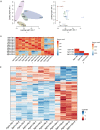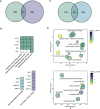AChR antibodies show a complex interaction with human skeletal muscle cells in a transcriptomic study
- PMID: 32641696
- PMCID: PMC7343820
- DOI: 10.1038/s41598-020-68185-x
AChR antibodies show a complex interaction with human skeletal muscle cells in a transcriptomic study
Abstract
Acetylcholine receptor (AChR) antibodies are the most important pathogenic marker in patients with myasthenia gravis (MG). The antibodies bind to AChRs on the postsynaptic membrane, and this leads to receptor degradation, destruction, or functional blocking with impaired signal at the neuromuscular junction. In this study, we have explored the effects of AChR antibodies binding to mature human myotubes with agrin-induced AChR clusters and pathways relevant for AChR degradation using bulk RNA sequencing. Protein-coding RNAs and lncRNAs were examined by RNA sequencing analysis. AChR antibodies induced marked changes of the transcriptomic profiles, with over 400 genes differentially expressed. Cholesterol metabolic processes and extracellular matrix organization gene sets were influenced and represent AChR-trafficking related pathways. Muscle contraction and cellular homeostasis gene sets were also affected, and independently of AChR trafficking. Furthermore, we found changes in a protein-coding RNA and lncRNA network, where expression of lncRNA MEG3 correlated closely with protein-coding genes for cellular homeostasis. We conclude that AChR antibodies induce an active response in human skeletal muscle cells which affects key intra- and extracellular pathways.
Conflict of interest statement
The authors declare no competing interests.
Figures








References
-
- Gilhus NE, et al. Myasthenia gravis—autoantibody characteristics and their implications for therapy. Nat. Rev. Neurol. 2016;12:259–268. - PubMed
-
- Keefe D, et al. A rapid, fluorescence-based assay for detecting antigenic modulation of the acetylcholine receptor on human cell lines. Cytom. Part B Clin. Cytom. 2009;76:206–212. - PubMed
-
- Tzartos SJ, et al. Main immunogenic region of Torpedo electroplax and human muscle acetylcholine receptor: localization and microheterogeneity revealed by the use of synthetic peptides. J. Neurochem. 1990;54:51–61. - PubMed
-
- Das MK, Lindstrom J. The main immunogenic region of the nicotinic acetylcholine receptor: interaction of monoclonal antibodies with synthetic peptides. Biochem. Biophys. Res. Commun. 1989;165:865–871. - PubMed
-
- Gullick WJ, Lindstrom JM. Mapping the binding of monoclonal antibodies to the acetylcholine receptor from Torpedo californica. Biochemistry. 1983;22:3312–3320. - PubMed
Publication types
MeSH terms
Substances
LinkOut - more resources
Full Text Sources
Medical

